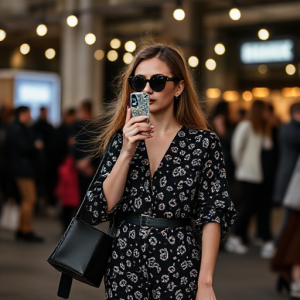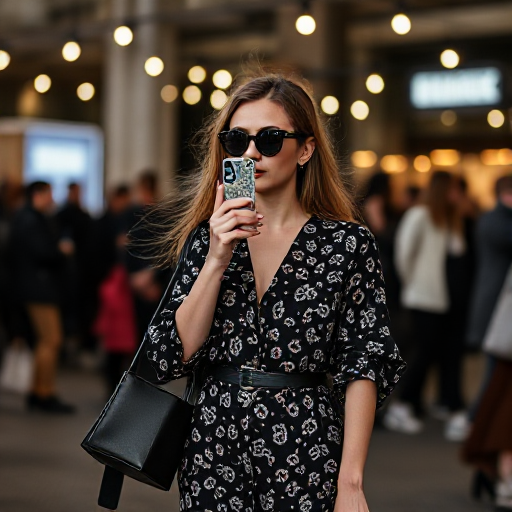
Influencer marketing has rapidly become one of the most effective strategies in the world of fashion. With the rise of social media platforms like Instagram, YouTube, TikTok, and others, influencers have amassed large followings, making them a powerful tool for fashion brands looking to reach their target audience. In this article, we’ll explore what influencer marketing is, why it works for the fashion industry, how to execute an influencer marketing campaign, and the best practices to ensure success.
What is Influencer Marketing?
Influencer marketing is a form of marketing where businesses collaborate with influential individuals, often called “influencers,” to promote their products or services. These influencers have a significant following on social media platforms and can sway the purchasing decisions of their audience. Influencers may be fashion bloggers, content creators, celebrities, or even micro-influencers with smaller, but highly engaged, followings.
In the fashion industry, influencer marketing can take many forms, including sponsored posts, product reviews, unboxing videos, and affiliate marketing. Fashion brands partner with influencers to leverage their credibility and reach to enhance brand awareness, drive sales, and connect with potential customers on a more personal level.
Why Influencer Marketing Works for Fashion
- Targeted Reach: Fashion influencers often specialize in specific niches (e.g., luxury, sustainable, streetwear, or plus-size fashion). This means that brands can target their ideal audience more precisely. For example, a sustainable fashion brand can work with influencers who promote eco-friendly lifestyles, ensuring their products are seen by individuals who value sustainability.
- Authenticity: One of the key reasons influencer marketing is so effective is because it is perceived as more authentic compared to traditional advertising. Followers trust the opinions and recommendations of influencers because they feel they have a genuine connection. When an influencer promotes a fashion brand, it feels like a personal endorsement, which builds trust with potential customers.
- Visual Appeal: Fashion is all about aesthetics, and influencers are masters at creating visually captivating content. Whether it’s through styled photoshoots, fashion hauls, or outfit-of-the-day posts, influencers can showcase products in an engaging and aspirational way. Their content often serves as fashion inspiration, leading to increased interest in the featured items.
- Social Proof: Seeing an influencer wear or promote a product acts as social proof for the brand. When followers see their favorite influencers wearing a particular brand or style, they are more likely to believe that the product is of high quality or that it aligns with their values. This type of endorsement is often more powerful than a brand’s own advertisements.
- Direct Engagement: Social media platforms allow brands to engage directly with their audience, and influencers serve as a bridge between the brand and the consumer. Influencers often interact with their followers, answer questions, and share behind-the-scenes content. This level of interaction fosters a sense of community and loyalty that can drive sales and strengthen the brand’s reputation.
Steps to Execute an Influencer Marketing Campaign for Fashion
- Define Your Objectives: Before you start working with influencers, it’s essential to have clear objectives. Do you want to increase brand awareness, drive traffic to your website, or boost sales of a specific product? Knowing your goals will help you choose the right influencers and measure the success of the campaign.
- Identify Your Target Audience: The next step is to understand your target audience. Consider factors such as age, gender, location, interests, and purchasing behavior. Your audience should align with the influencer’s following. If you are targeting Gen Z consumers, influencers who cater to that demographic will be more effective.
- Select the Right Influencers: Choosing the right influencers is crucial to the success of your campaign. There are three main categories of influencers:
- Mega-influencers: Celebrities or individuals with millions of followers. While they have massive reach, their engagement rates can sometimes be lower, and their audience might be less niche.
- Macro-influencers: Influencers with a substantial following (hundreds of thousands to a million). They have more niche audiences and better engagement rates than mega-influencers.
- Micro-influencers: Influencers with smaller followings (10,000 to 100,000) but highly engaged audiences. Micro-influencers are often seen as more relatable and trustworthy, making them ideal for niche markets.
- Nano-influencers: Influencers with under 10,000 followers. Although they have a smaller reach, they tend to have the highest engagement rates and can be very effective for highly targeted campaigns.
- When choosing an influencer, consider their engagement rate, content quality, and alignment with your brand’s values and aesthetics. It’s not just about the number of followers; the authenticity and relationship they have with their audience are just as important.
- Create a Compelling Offer: Once you’ve identified your influencers, it’s time to approach them with an offer. This can be a monetary payment, free products, or an affiliate partnership. The offer should align with the influencer’s usual content and interests to ensure a natural promotion.
- Develop a Clear Brief: Provide influencers with a clear campaign brief outlining the deliverables, timeline, and key messages. Make sure to give them creative freedom, as their followers appreciate authentic content. Be specific about your goals and expectations but allow them to tailor the promotion to their unique style.
- Track Performance and Measure Results: After launching the campaign, track the results to assess its effectiveness. Use metrics such as engagement rate, website traffic, sales, and the number of new followers gained. Social media platforms also offer analytics tools that can help you track how well your influencer collaborations are performing.
Best Practices for Influencer Marketing in Fashion
- Build Long-Term Relationships: Instead of one-off collaborations, consider building long-term partnerships with influencers. This fosters a deeper connection with the audience and makes the influencer’s promotion feel more genuine. Long-term collaborations can also lead to more consistent content and stronger brand association.
- Use Diverse Influencers: Don’t limit yourself to working with only one type of influencer. Collaborate with a diverse range of influencers to reach different segments of your audience. This can include fashion influencers of different ages, sizes, ethnicities, and backgrounds. Diversity in influencer marketing helps build a more inclusive brand image.
- Leverage User-Generated Content: Encourage influencers to create content that showcases your products in real-life situations. User-generated content (UGC) not only promotes your brand but also creates social proof, as potential customers see real people wearing your products. UGC can be repurposed for your own marketing channels as well.
- Ensure Transparency: It’s essential that influencers disclose any sponsored content in line with legal requirements. Transparency helps maintain trust with their audience and ensures compliance with advertising regulations.
- Stay Authentic: Authenticity is key in influencer marketing. Avoid working with influencers who promote products that don’t align with their personal brand or style. Audiences can tell when a promotion feels forced or disingenuous, which can harm the brand’s reputation.
Influencer marketing for fashion offers brands the opportunity to connect with their target audience in a more personal and engaging way. By partnering with the right influencers, creating authentic content, and measuring the success of your campaigns, you can elevate your brand and drive significant results. As the fashion industry continues to evolve, influencer marketing remains one of the most powerful tools for brands looking to make an impact and stay relevant in an ever-changing market.
